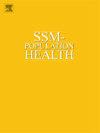Does change in area-level deprivation, change health outcomes? A latent class growth analysis of population data
IF 3.1
2区 医学
Q1 PUBLIC, ENVIRONMENTAL & OCCUPATIONAL HEALTH
引用次数: 0
Abstract
While deprivation is consistently predictive of health, it is typically studied at one point in time in relation to health outcomes. Emerging research indicates that trajectories of social mobility may be a more powerful predictor of health than point-in-time analyses. This study seeks to identify distinct area-level deprivation trajectories within the Northern Ireland (NI) population over multiple time-points and their associations with all-cause mortality; receipt of psychotropic medication; and presentations to Accident and Emergency (A&E) departments.
Based on linkage of NI GP registration, prescription, A&E and mortality data from 2010 to 2021, we used latent class growth analysis to identify trajectories in area-level deprivation from 2010 to 2016. Adjusting for baseline socio-demographic characteristics, we estimated the relationship between trajectories and health outcomes between 2017 and 2021.
We identified three stable, two downwardly mobile and two upwardly mobile classes. Upward mobility was associated with reduced risk of poor health outcomes compared to the consistently deprived. Downward mobility was associated with higher risk of poor health outcomes compared to the consistently non-deprived. An approximate dose-response relationship was observed across classes, whereby lower ‘endpoint’ deprivation in 2016 was associated with lower risk of adverse outcomes. The exception was the ‘substantial upward mobility’ class, with risk of poor outcomes second highest despite improved deprivation rank in 2016.
The classes of social mobility identified potentially provide a template within which social mobility can be studied in future research, highlighting the importance of both point of origin and destination in the study of social mobility and health.
地区贫困程度的改变会改变健康结果吗?人口数据的潜在阶级增长分析
虽然贫困始终是健康的预测因素,但通常是在某个时间点对其与健康结果的关系进行研究。新兴研究表明,社会流动轨迹可能比时间点分析更能预测健康状况。本研究旨在确定北爱尔兰人口在多个时间点上的不同区域水平的剥夺轨迹及其与全因死亡率的关系;接受精神药物治疗;并向事故和紧急情况部门作报告。基于2010年至2021年NI GP注册、处方、A&;E和死亡率数据的联系,我们使用潜在类别增长分析来确定2010年至2016年区域水平剥夺的轨迹。调整基线社会人口特征后,我们估计了2017年至2021年间轨迹与健康结果之间的关系。我们确定了三个稳定阶层,两个向下流动阶层和两个向上流动阶层。与长期处于贫困状态的人相比,向上流动与健康状况不佳的风险降低有关。与一直没有被剥夺权利的人相比,向下流动的人健康状况不佳的风险更高。在不同类别中观察到近似的剂量-反应关系,因此2016年较低的“终点”剥夺与较低的不良后果风险相关。唯一的例外是“大幅向上流动”阶层,尽管2016年贫困程度排名有所提高,但结果不佳的风险排名第二。所确定的社会流动类别可能为今后的研究提供社会流动研究的模板,突出了社会流动和健康研究的起源点和目的地的重要性。
本文章由计算机程序翻译,如有差异,请以英文原文为准。
求助全文
约1分钟内获得全文
求助全文
来源期刊

Ssm-Population Health
PUBLIC, ENVIRONMENTAL & OCCUPATIONAL HEALTH-
CiteScore
6.50
自引率
2.10%
发文量
298
审稿时长
101 days
期刊介绍:
SSM - Population Health. The new online only, open access, peer reviewed journal in all areas relating Social Science research to population health. SSM - Population Health shares the same Editors-in Chief and general approach to manuscripts as its sister journal, Social Science & Medicine. The journal takes a broad approach to the field especially welcoming interdisciplinary papers from across the Social Sciences and allied areas. SSM - Population Health offers an alternative outlet for work which might not be considered, or is classed as ''out of scope'' elsewhere, and prioritizes fast peer review and publication to the benefit of authors and readers. The journal welcomes all types of paper from traditional primary research articles, replication studies, short communications, methodological studies, instrument validation, opinion pieces, literature reviews, etc. SSM - Population Health also offers the opportunity to publish special issues or sections to reflect current interest and research in topical or developing areas. The journal fully supports authors wanting to present their research in an innovative fashion though the use of multimedia formats.
 求助内容:
求助内容: 应助结果提醒方式:
应助结果提醒方式:


